Smoothie Shakedown: drinkable fruit...or fruity sugar drink?

anasegota - pixabay.com (top green smoothie), fox17 - stock.adobe.com (top pink smoothie),
By Lindsay Moyer & Bonnie Liebman
“ Whole fruit!” says Jamba Juice, where you can “power up with clean energy” and “start drinking” your greens.
“Smoothies with a purpose,” says Smoothie King, where you can choose from Fitness Blends, Slim Blends, and Wellness Blends, among others.
Smoothies have a huge health halo. Do they deserve it? Even the best smoothie doesn’t hold a candle to a peach, a plum, carrots, or kale. Liquid calories don’t curb your appetite as well as fruits or vegetables that you chew.
But some smoothies are 800-to-1,000-calorie sugar drinks, while others can rival a homemade blend of your favorite fruit and plain yogurt. Here’s how to see through the marketing schemes and scams.
No Sugar?
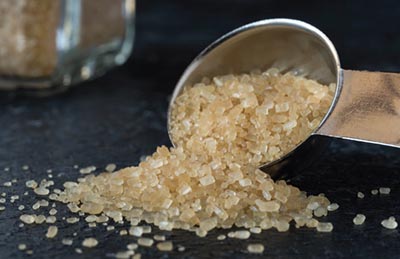
Tropical Smoothie Cafe sweetens nearly all of its smoothies with turbinado sugar (coarse brown cane sugar), but leaves it out if you ask.
And Smoothie King leaves raw cane sugar out of its Take a Break Blends if you ask. What’s more, the chain is dropping all added sugars from most of its smoothies.
Jamba Juice? “Our blends have no pumps, no added purees, and no turbinado sugars,” the chain brags. “It’s all real at Jamba.” Yet there’s still plenty of “real” added sugar in the frozen yogurt, Chocolate Moo’d base (think chocolate milk), soy milk, almond milk, sherbet, or honey that Jamba adds to some of its smoothies. Ouch.
TIP: At Tropical Smoothie Cafe, you lose roughly 240 calories (and 14 teaspoons of sugar) if you axe the turbinado in most blends. You’d also be smart not to add Splenda (sucralose). Smoothie King’s “stevia plant-based sweetener”—stevia extract plus erythritol—is safe. (See chemicalcuisine.org.)
A Word to the Size
Hold on to your straw. At Jamba Juice, smoothies range from 16 oz. smalls (typically 200 to 400 calories) to 28 oz. larges (400 to 700 calories).
You’re also in for 400 to 700 calories at Tropical Smoothie Cafe, where your only option is 24 oz.
Smoothie King’s small starts at 20 oz. and its large hits 40 oz. (1¼ quarts). Chalk up 300 to 1,000 calories. What’s next: the 64 oz. (half-gallon) bucket?
TIP: Stick with the smallest size. Even better: share with a friend or freeze some for later.
Whole Fruit?
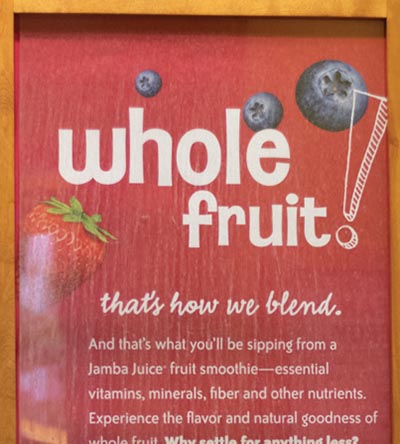
“Whole fruit!” shout the signs at Jamba Juice.
“That’s how we blend...why settle for any thing less?”
Why, indeed. Whole fruit is healthier than juice. You get more fiber and fewer calories. But at Jamba, nearly every fruit smoothie is made with fruit juice—though the menu board rarely says so—along with fruit.
And, several Jamba outlets told us, many are made with a juice blend that has more (cheap, nutrient-poor) apple, grape, or pear juice than the pomegranate, peach, mango, or other pricey fruit in the smoothie’s name. Others have “lemonade” (read: white grape juice and lemon juice from concentrate).
What’s more, many of Jamba’s smoothies are made with its sugary Chocolate Moo’d base, sherbet, or frozen yogurt (basically nonfat ice cream). So much for the website’s promise to “only use real whole fruit and veggies, and wholesome ingredients.”
And when Tropical Smoothie Cafe’s menu board says cranberry, lime, kiwi, or pomegranate, expect juice plus added sugar—not whole fruit—several outlets told us. As for “acai,” you’re looking at acai purée plus water and sugar. “Coconut”? It means coconut milk plus sugar.
TIP: Drop the juice. Ask for milk (nonfat at Smoothie King or 2% at Jamba) or unsweetened almond milk (at Smoothie King) plus fruit instead. Dairy milk means more protein and other nutrients.
Protein Smoothie Time?
“Blended to help you get toned, build muscle, last longer or recover faster,” says Smoothie King.
“Snack time? Workout time? Sounds like it’s protein smoothie time,” says Jamba Juice.
Companies push protein smoothies as a “snack” to help people “recover” from their workouts. Odds are, most of those smoothie calories will end up in your spare tire, not your biceps.
Thanks to hefty doses of juice or milk, frozen or dried fruit, nuts or nut butters, protein powder, and more, many smalls start around 400 calories. Larges rise to 700-plus.
For example, Jamba Juice’s PB & Banana Protein Smoothie (milk, banana, peanut butter, whey protein, honey) ranges from 490 calories in a (16 oz.) small to 740 in a (28 oz.) large. The Cookies ‘n Crème—think blended cookies instead of peanut butter and honey—is in the same ballpark. Some snack.
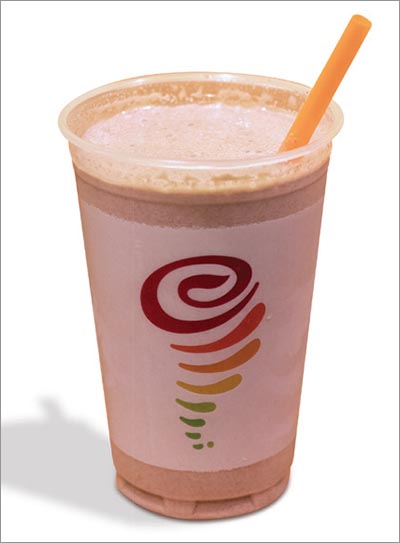
Tropical Smoothie Cafe’s 24 oz. Chia Banana Max hits 880 calories, thanks to banana, chia, almonds, oats, dates, sweetened coconut milk, peanut butter, and whey protein, topped off with roughly seven teaspoons of turbinado sugar.
But super-sized Smoothie King takes the cake. Its Peanut Power Plus Chocolate (bananas, peanut butter, dates, “protein blend,” nonfat milk, cocoa) squeezes 580 calories into a (20 oz.) small and 1,160 into a (40 oz.) large. So much for that workout.
What’s more, Smoothie King’s “Lean1” and “Gladiator” protein powders have (unsafe) sucralose. So does Tropical Smoothie’s pea protein. And its soy and whey have (poorly tested) acesulfame potassium. At least Jamba’s soy and whey are unsweetened.
TIP: Protein smoothie fan? Stick to a small with just milk, fruit, and protein powder. A small Jamba Protein Berry Workout (soymilk, strawberries, bananas, whey) has 290 calories and 17 grams of protein. Ask for 2% milk to dodge the added sugar (6½ teaspoons per cup) in Jamba’s soymilk.
Slim Smoothies?

Slim Blends are “blended to help you slim down, lighten up or reduce calories as part of a sensible diet and exercise plan,” says Smoothie King.
What’s so slimming about a small (20 oz.) MangoFest (mango plus juice blends) or Pineapple Mango Lean1 Smoothie (mango, pineapple, protein powder, pineapple mango juice blend), for example? Each delivers nearly 300 liquid calories. Larges top 550.
Smoothie King also pushes a Diet Down “enhancer,” including “green tea to increase fat metabolism” and “chromium to help burn carbohydrates and fats.” Will adding it (for an extra 99 cents) make a dent in the damage done by your 300-calorie smoothie? Fat chance.
The same goes for Tropical Smoothie Cafe’s Lean Machine, a 490-calorie fruit smoothie plus “fat burner” supplement cocktail with useless ingredients like Garcinia cambogia and raspberry ketone.
TIP: Don’t fall for slimming smoothies. Companies don’t need solid evidence to make claims about supplements, so they promise what sells. Rule #1 for dieters: Don’t drink your calories.
Coffee with No Guilt?
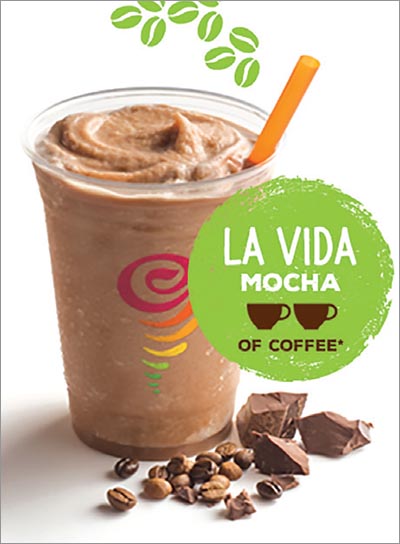
“Kick start your day with Jamba’s new Cold Brew Coffee Blends,” says Jamba Juice. “Using sustainably-sourced coffee ingredients, our La Vida Mocha and Lotta Horchata smoothies have all the caffeine and flavor, with none of the added guilt.”
Time to swap your morning coffee for a coffee smoothie? Only if you’re looking to start your day with dessert.
Even a small (16 oz.) Lotta Horchata Smoothie (coffee, chia, honey, almond milk, nonfat frozen yogurt) has 210 calories and 26 grams (six teaspoons) of sugar—nearly all of it added. That’s around half a day’s limit. A large has 360 calories and 12 teaspoons of sugar. Yup, that’s a Lotta.
The La Vida Mocha blends coffee with nonfat frozen yogurt and Jamba’s sugary Chocolate Moo’d base. With 290 calories and 49 grams (12 teaspoons) of (mostly added) sugar, a (16 oz.) small is like drinking a Starbucks grande Coffee Frappuccino. A large—with 530 calories and 21 teaspoons of sugar—is almost like having a McDonald’s Vanilla Cone plus a large Coke (24 oz.). Ay, caramba!
Smoothie King’s Coffee High Protein smoothies may not add sugar, but they’re packed with enough protein powder, almonds, milk, and dates in each (20 oz.) small to rack up 390 calories. Double that for a large.
TIP: For “none of the added guilt,” have a cup of coffee.
Drink Your Greens?
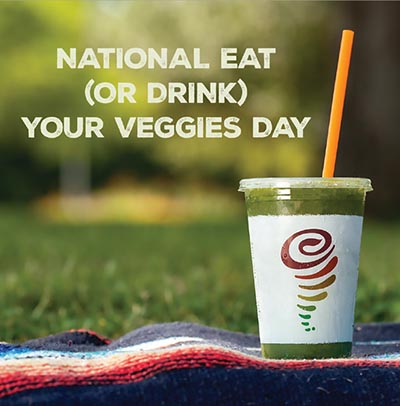
“Struggling to eat enough greens? Start drinking them!” says Jamba Juice.
Greens are a big draw in smoothie world. Watch out.
You’re getting way more fruit-plus-juice than puréed kale and ginger in, say, a Jamba Juice Greens ’n Ginger Smoothie.
Even a medium (22 oz.) Greens ’n Ginger delivers 440 calories and 90 grams (21 teaspoons) of sugar. Jamba doesn’t say how much sugar is from the juice and how much is from the fruit, but one thing is clear: it’s no liquid salad.
Jamba’s Apple ’n Greens and Amazing Greens smoothies also blend in sugary liquids (like apple-strawberry juice blend or lemonade).
Smoothie King's Veggie Blends smoothies play the same game. The Apple Kiwi Kale has apple juice and “kiwi juice blend” along with its kale and banana, and the Lemon Ginger Spinach has “papaya juice blend” along with its spinach, kale, carrots, and fruit. Of course, the menu doesn’t let on that the kiwi juice or papaya purée is blended with (cheap) apple juice and other juices.
Similarly, Panera’s 200-calorie Green Passion smoothie has more “peach mango base” (fruit purées, fruit juice concentrates, water, natural flavors) than spinach.
TIP: You can do better at Tropical Smoothie Cafe. The 24 oz. Detox Island Green—spinach, kale, mango, pineapple, banana, ginger—has no fruit juice and only 180 calories.
(“Detox” simply means that you skip the hefty dose of turbinado sugar in the Cafe’s regular Island Green, which packs more than twice the calories. You’re detoxing the smoothie, not you.)
How Much Yogurt?
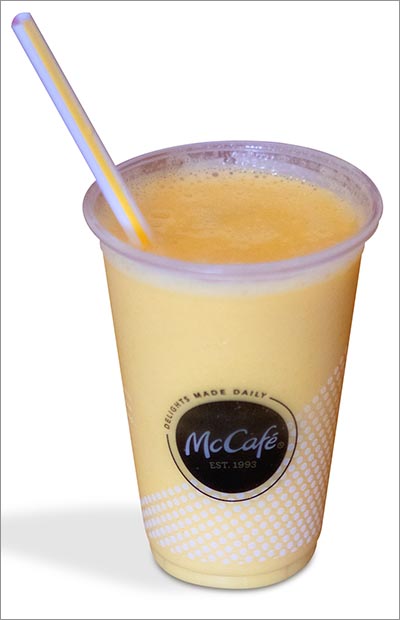
“Blended with creamy low fat yogurt,” says McDonald’s about its McCafé Mango Pineapple or Strawberry Banana Smoothie.
“Blended with very little yogurt,” is more like it, judging by the paltry three grams of protein in a (16 oz.) medium. Much of its 250-or-so calories comes from a “fruit base” (water, juice concentrates, and purées).
Likewise, Tropical Smoothie Cafe promises yogurt in its 450-calorie Kiwi Quencher (kiwi juice, strawberries, “non-fat yogurt”) and 400-calorie Mango Magic (mango, pineapple, “non-fat yogurt”). Yet each 24 oz. smoothie delivers only 2 or 3 grams of protein.
What gives? The Cafe’s “non-fat yogurt” is frozen yogurt, shops told us, which has no more protein than most ice creams.
TIP: Jamba Juice will “boost” any smoothie with the 5 grams of protein (and 25 calories) in a scoop of nonfat plain greek yogurt for 75 cents. Or, at no extra cost, you can swap greek yogurt for any smoothie’s sherbet or fro-yo.
A Real Meal?
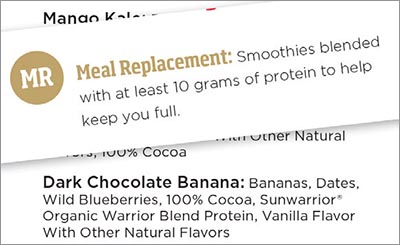
At Smoothie King, more than a dozen smoothies carry an “MR” (meal replacement) symbol, because they’re “blended with at least 10 grams of protein to help keep you full,” says the company.
And last year, the chain urged customers to “Sip Your Way to Your Goal Weight” by replacing one meal a day with an under-400-calorie smoothie.
But there’s more to a healthy meal than 10 grams of protein. (Vegetables, anyone?) And it’s not clear that protein helps “keep you full,” especially when you’re drinking your calories.
What’s more, even many of the King’s small smoothies are no calorie bargain. The Dark Chocolate Banana Smoothie (banana, dates, blueberries, cocoa, protein powder), for example, has just 11 grams of protein. You’d get that from a 5 oz. container of greek yogurt...for less than half the smoothie’s 350 calories.
TIP: Want a meal? Try Jamba Juice’s Fruit and Greek Yogurt Bowl (31 grams of protein) for breakfast. Instead of a smoothie, you get greek yogurt with bananas, berries, granola, and honey for 390 calories. Better yet, get no honey and a light sprinkle of granola.
The information for this article was compiled by Jolene Mafnas.
Photos: anasegota/pixabay.com (top green smoothie), fox17/stock.adobe.com (top pink smoothie), Michelle/stock.adobe.com (turbinado sugar), Jennifer Urban/CSPI (Jamba Juice protein smoothie, McCafé Mango Pineapple smoothie).

